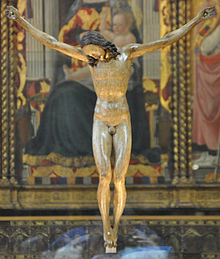Crucifix (Michelangelo)
| Crucifix | |
|---|---|
 | |
| Artist | Michelangelo |
| Year | 1492 |
| Type | Polychrome wood |
| Dimensions | 142 cm × 35 cm (55.9 in × 13.8 in) |
| Location | Santo Spirito, Florence |
| Preceded by | Battle of the Centaurs (Michelangelo) |
| Followed by | St. Petronius (Michelangelo) |
Two different crucifixes, or strictly, wooden corpus figures for crucifixes, are attributed to the High Renaissance master Michelangelo, although neither is universally accepted as his. Both are relatively small figures which would have been produced in Michelangelo's youth.
Santo Spirito figure
One is a polychrome wood sculpture possibly finished in 1492 which had been lost from view by scholars until it re-emerged in 1962; in 2001 new investigations appeared to confirm the attribution to Michelangelo.[1] It was perhaps made for the high altar of the Church of Santo Spirito di Firenze in Florence, Italy. The work is especially notable for the fact that this Christ is naked.
History
Michelangelo Buonarroti was a guest of the convent of Santa Maria del Santo Spirito (Florence) when he was seventeen years old, after the death of his protector Lorenzo de' Medici. Here he could make anatomical studies of the corpses coming from the convent's hospital; in exchange, he is said to have sculpted the wooden crucifix which was placed over the high altar. Today the crucifix is in the octagonal sacristy of the Basilica of Santa Maria del Santo Spirito.
Description
The nudity of the figure is true to the Gospels. Christ's clothing being removed by Roman soldiers is offered as the fulfilment of Psalm 22:18, "They part my garments among them, and cast lots upon my vesture." All of the Gospel writers suggest the nakedness, while John supplies the details:
Then the soldiers, when they had crucified Jesus, took his garments, and made four parts, to every soldier a part; and also his coat: now the coat was without seam, woven from the top throughout. They said therefore among themselves, Let us not rend it, but cast lots for it, whose it shall be: that the scripture might be fulfilled, which saith, 'They parted my raiment among them, and for my vesture they did cast lots.' These things therefore the soldiers did.
The sign attached to the cross includes Jesus' accusation inscribed in Hebrew, Greek and Latin. The wording translates "Jesus of Nazareth King of the Jews". All of the evangelists record this inscription, which varies slightly among them. Here the artist favored the rendering from John's Gospel (John 19:19).
Also present is the spear wound inflicted into Jesus' side by a Roman soldier. His blood is seen here dripping from the wound on his right side.
Other crucifix attributed to Michelangelo

In December 2008, the Italian government acquired from the antique dealer Giancarlo Gallino for €3.2 million another polychrome corpus for a crucifix in limewood;[2][3] this is less than half the size of the Santo Spirito figure. The figure had been previously exhibited in 2004 in the Museo Horne in Florence.[4]
Some art historians attributed the work to Michelangelo based only on stylistic criteria, as the sculpture is not documented by contemporary biographers of Michelangelo Ascanio Condivi and Giorgio Vasari. The figure measures 41.3 by 39.7 centimetres (16.3 in × 15.6 in) and was allegedly made around 1495.[2] In December 2009, an inquiry has been opened into the acquisition of the crucifix by the Italian state.[5] ANSA reports that:[5] "several experts have cast doubts on the attribution, with the doyenne of Michelangelo cross studies, German art historian Margrit Lisner, saying it was probably a Sansovino."
There have been academic debates regarding the authenticity of the two crosses already attributed to Michelangelo. In a book published by the Leipzig University Press in 2019,[6] the Milanese restaurator and art historian Antonio Forcellino takes a position in the discussion about Michelangelos crucifix of Santo Spirito. There he identifies Michelangelo's crucifix of Santo Spirito as a wooden crucifix that is still privately owned. Antonio Forcellino attributes this work to Michelangelo not only because of its display of anatomical detail but mainly due to an epigraph, which was inscribed on the back of the work at the beginning of the 18th century.[7]
See also
Notes
- ^ Crucifix 'confirmed' as a Michelangelo. BBC News, 18 July 2001. Retrieved on 18 May 2009
- ^ a b Elisabetta, Povoledo (22 April 2009). "Yes, It's Beautiful, the Italians All Say, but Is It a Michelangelo?". The New York Times. Retrieved 30 April 2010.
- ^ "Crucifix". Michelangelo. Archived from the original on 2014-06-13. Retrieved 2021-06-22.
- ^ Giancarlo Gentilini, Proposta per Michelangelo Giovane. Un Crocifisso in legno di tiglio, catalogo della mostra, Firenze, Museo Horne, 8 maggio - 4 settembre 2004, Torino, 2004.
- ^ a b "Michelangelo cross buy probe - Investigators suspect fraud". ANSA. 2009.[permanent dead link]
- ^ Götterhimmel und Künstlerwerkstatt: Perspektiven auf die Kunst der italienischen Renaissance, Leipziger Universitätsverlag, 2019
- ^ Tanti, Cassandra (June 28, 2019). "Michelangelo in Monaco". Monaco Life.
References
- Condivi, Ascanio; Alice Sedgewick (1999). The Life of Michelangelo. Pennsylvania State University Press. ISBN 0-271-01853-4.
- Baldini, Umberto; Liberto Perugi (1982). The Sculpture of Michelangelo. Rizzoli. ISBN 0-8478-0447-X.
External links
![]() Media related to Santo Spirito Crucifix by Michelangelo Buonarroti at Wikimedia Commons
Media related to Santo Spirito Crucifix by Michelangelo Buonarroti at Wikimedia Commons
